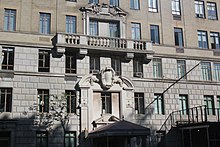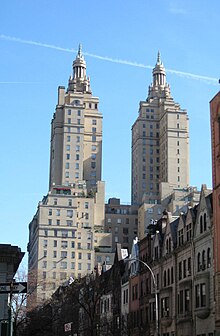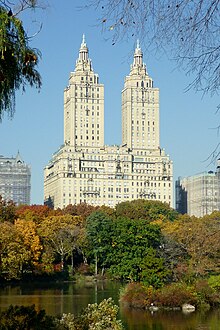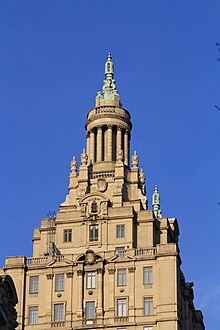The San Remo
[11][12] Major developments on the West Side were erected after the Ninth Avenue elevated line opened in 1879, providing direct access to Lower Manhattan.
[15][16] The city installed power lines on Central Park West at the end of the 19th century, thus allowing the construction of multi-story apartment hotels with elevators.
[23] The San Remo is one of four buildings on Central Park West with a twin-towered form;[19] the others are the Century, the Majestic, and the El Dorado.
[30][b] Roth designed spires that were 400 ft (120 m) high; according to general contractor HRH Construction; this made the building one of New York City's tallest residential structures.
[19] The San Remo was the earliest apartment building on Central Park West to be built with twin towers following the passage of the Multiple Dwelling Act of 1929.
[6] These details include pilasters, engaged columns, rounded and triangular broken pediments, and balustrades, as well as smaller motifs such as roundels, scrolls, urns, cartouches, garlands, and consoles.
[6][42] Roth anticipated that the upper and lower transoms would provide suitable air circulation most of the time and that the casements would only need to be opened on especially hot days.
The westernmost end of the 74th Street frontage, next to the service gate, contains a metal fence atop a brick parapet, which encloses an unused courtyard.
The third-story windows in these bays are flanked by limestone frames with rosettes and consoles; these support small balustrades at the fourth story.
[48] Above the terrace level, a circular podium supports a set of console brackets, atop which is an electric copper lantern with windows on four sides.
The walls are flat and contain red-and-brown marble doorways leading to various rooms, as well as lighting sconces made of glass and metal.
[32] Over the years, apartment layouts have been modified to accommodate the needs of individual tenants,[30] and obliquely shaped spaces such as semicircular dining rooms were also created.
[53][58] By the late 1920s, high-rise apartment buildings were being developed on Central Park West in anticipation of the completion of the New York City Subway's Eighth Avenue Line, which opened in 1932.
[61] Two weeks later, a syndicate led by Henry M. Pollock bought the old San Remo from the Brennan estate, as well as several adjacent four-story houses to the west.
[27] The next month, Emery Roth filed plans for a 16-story apartment building on the site of the San Remo Hotel to cost $2.5 million.
[22] The Bank of United States provided a $5 million loan in January 1930 to City Financial Corporation, one of its subsidiaries, which owned the building.
[78] Early the next month, contractors placed $423,000 worth of liens against San Remo Inc.,[79] and the Bank of United States moved to foreclose on the building's $5 million mortgage loan.
[42][76] The owners reduced rents and created 20 additional apartments by subdividing four of the duplexes in the south tower and some vacant units at the base.
[99] The journalist Peter Osnos wrote that the San Remo and other Central Park West apartment houses contained many Jewish residents during the 1930s and 1940s, since these buildings were not "restricted", unlike others on the East Side.
[100] In July 1940, a group of anonymous investors acquired the San Remo and Beresford, assuming a combined $7.4 million in mortgages on the two structures.
[108] Helmsley lost $1.25 million in the process, amid a weakening market for co-op apartments, and the San Remo reverted to its previous owners.
[124] Many residents had complained that director Steven Spielberg and entrepreneur Steve Jobs were conducting multi-year renovations of their respective apartments.
[127] The San Remo attracted many residents in the entertainment industry, especially as compared to other Central Park West buildings, where wealthy people lived in relative obscurity.
[128][160] Tenants cited concerns that Madonna's presence would attract paparazzi,[160] although, at the time, nude pictures of her had recently circulated in Playboy and Penthouse magazines.
[160][161] Madonna ultimately bought another apartment on Central Park West;[7] the San Remo's board eventually approved her application more than two decades later, in 2008.
[166] In September 2012, New York Times columnists wrote "for the past few elections, the San Remo has been an ATM for Democratic presidential campaigns", though contributions through July 2012 favored Romney over Obama, $331,625 to $101,367.
[164] Because the San Remo was the earliest twin-towered apartment building on Central Park West, its completion attracted large amounts of commentary from the press.
[171] The writer Elizabeth Macaulay-Lewis said in 2021: "The San Remo's Choragic towers served as outward markers of architectural elegance that could be used to lend distinction to broad, tall apartment buildings that might otherwise run the risk of being drably similar to one another.
[173] John Freeman Gill of the Times wrote in 2005 that the San Remo was one of several buildings on Central Park West whose bases exhibited "the comfortable old solidity of limestone".
In 1996, a writer for Interior Design magazine said the San Remo was "among the Upper West Side's top-drawer co-ops, the buildings that evoke the basic emotions of lust and envy when one thinks-or dreams-of the apartments within".





